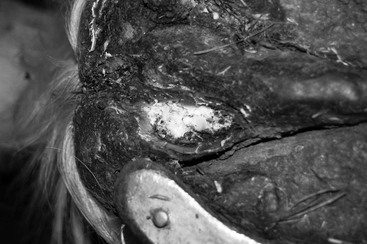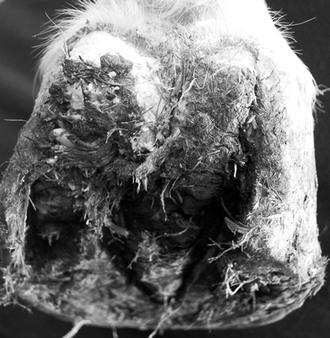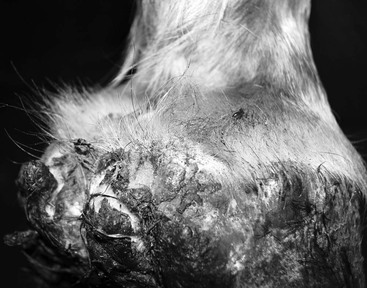Maarten Oosterlinck
Canker
Equine proliferative pododermatitis, or canker, is a debilitating disease of the hoof characterized by chronic proliferation of horn-producing tissues, mainly in the frog region but sometimes also undermining the sole, heel bulbs, and, less commonly, the hoof wall. It is not a true neoplasm, but rather is a chronic inflammatory reaction with excessive dyskeratosis, resulting in exuberant horn of inferior quality. As opposed to thrush, which causes superficial degenerative keratolysis in the sulci of the frog, canker is a proliferative disease affecting the horn of the frog anywhere throughout its structure. Canker has been reported to have a higher prevalence in the hind limb, although forelimb involvement is also common. The disease has been considered to occur mainly in draft horses, but other breeds can equally be affected. Most horses have several hooves affected, although involvement of a single hoof can occur. Although horses often have local sensitivity at the level of the lesions, overt lameness is mostly associated with advanced infection or a concurrent hoof problem, such as a hoof abscess, laminitis, or other condition.
Canker is generally regarded as a rare diagnosis in modern equine practice, with a higher prevalence seen in the semitropical climate of the southern United States. However, notwithstanding improvements in horse management and hoof care, the disease has not been eliminated, and some authors have even reported an increased prevalence that may in part be a result of increased awareness of the condition.
Etiology
The etiology of canker remains obscure: infectious agents such as anaerobic bacteria, viruses, fungi, and spirochetes have been isolated from diseased tissue, but the causal relationship between specific organisms and canker remains unclear, and wet or unhygienic environmental conditions have also been blamed as inciting factors. Moreover, an immunologic etiology has been hypothesized, which may be linked with a genetic predisposition. It cannot be excluded that canker may have several etiologies, which may explain differences in clinical presentation and response to treatment.
Diagnosis
Diagnosis is generally made on the basis of history and the pathognomonic appearance of hoof tissue, most frequently foul-smelling, cheesy masses with filamentous or cauliflower-like epithelial proliferations, often extending from the caudal part of the frog to the heel bulbs and bleeding on manipulation; affected horses often also have upright hairs at the heel bulbs (Figures 198-1 to 198-3). In horses with moderate to severe stages of the disease, biopsy for histologic evaluation is unnecessary. Culture is generally unrewarding because the tissue typically yields a variety of organisms. It may be suggested that any case of thrush that does not rapidly respond to a standard treatment should be considered canker.

The disease remains underdiagnosed. Although equine veterinarians and farriers possess a common body of knowledge regarding hoof canker, diagnosis in the early stages of the disease is rarely made correctly, and inadequate treatments are used persistently. In a recent retrospective study, an initial presumptive diagnosis of thrush was made in 19 of 28 horses, and 10 of those 19 horses had been treated accordingly for several months. Overall, horses had been treated for weeks (5/28), months (16/28), or even several years (7/28) before being referred for further investigation and treatment. At first evaluation, differentiating between canker and thrush may be difficult for a farrier or veterinarian with limited experience because both conditions are associated with structural degradation and superficial bacterial contamination. However, lesions extending outside the sites where thrush is common or that arise in locations distant from the predilection sites for thrush (i.e., the sulci of the frog), the macroscopic appearance of underlying tissues that bleed profusely when manipulated, and the lack of response to standard treatment for thrush should alert caretakers and veterinarians to consider the possibility of canker. Better awareness of the condition and adequate education to recognize early stages of the disease are needed.





